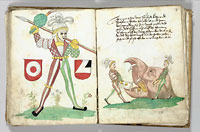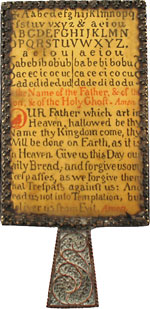Fête Accompli
16th-Century Carnival Books, Christie’s New York, $158,500
A carnival parade for Shrove Tuesday (Fassnacht) was one of the great civic spectacles of Renaissance Nuremberg. In 1349, as a reward for not joining a revolt of trade guilds, the Emperor Charles IV had granted the butchers’ guild the right to a public celebration, the Schembart, at which participants could wear masks, dance, hold fencing matches and parade.
Dancers were protected or flanked by laüfer, runners whose own performance gradually evolved to become the main event. Wearing masks and costumes decorated with embroidery, ribbons and bells, they ran through the streets brandishing lances and bunches of leaves, lebensrute, that concealed fireworks.
Sometimes the Schembart itself led to public disorder and it was this that brought about their demise in 1539. Reformers had long objected to the general rowdiness but in that year they were further outraged by the presence on one carnival float of a figure of the Lutheran minister Osiander holding a backgammon board and surrounded by fools and devils.
Manuscript and printed books recording the carnival and their costumes began to appear almost immediately after the ban and may well have been part of an attempt to get the festival revived.
Over 80 early manuscripts survive, most now in German institutions, but until this summer only two others had been offered at auction in the last 50 years—both in June 2006. Then on June 12, at Christie’s New York, no fewer than six Schembart books (once in the library of the Princes of Liechtenstein) were offered as part of a magnificent collection of early fêtebooks formed over a lifetime by Paul and Marianne Gourary of New York.
One manuscript of c.1540 sold at $158,500 to a British dealer but the spread shown here comes from another of similar date containing a cycle of full-page colour illustrations of masked and costumed figures from all 64 carnivals held in the years 1449-1539. It sold at $128,600 to an American institution.
A is for Alphabet
Undated Hornbook, Woolley & Wallis, Salisbury, $8,625
Over the centuries, children have used hornbooks to learn their letters and set out on the path of reading and writing. Though endlessly handed down to succeeding generations, and thus liable to become worn or broken and discarded, vast numbers were produced over the ages, from precious silver and ivory examples used by the children of the wealthy, to those that were simply pieces of paper stuck on wood.
Hornbooks made from the long-lasting material that gives these reading primers their generic name were once reasonably easy to find, but this English provincial sale of June 17 offered what is nowadays a rare opportunity to acquire one.
Undated, but of traditional form in presenting the alphabet in both lower case and capital letters, followed by the Lord’s Prayer, this example is set in a chased and filigree worked silver-plate frame. Valued at around $450-750, it went on to sell for £5,260 ($8,625).








 Ian McKay’s weekly column in Antiques Trade Gazette has been running for more than 30 years.
Ian McKay’s weekly column in Antiques Trade Gazette has been running for more than 30 years.
